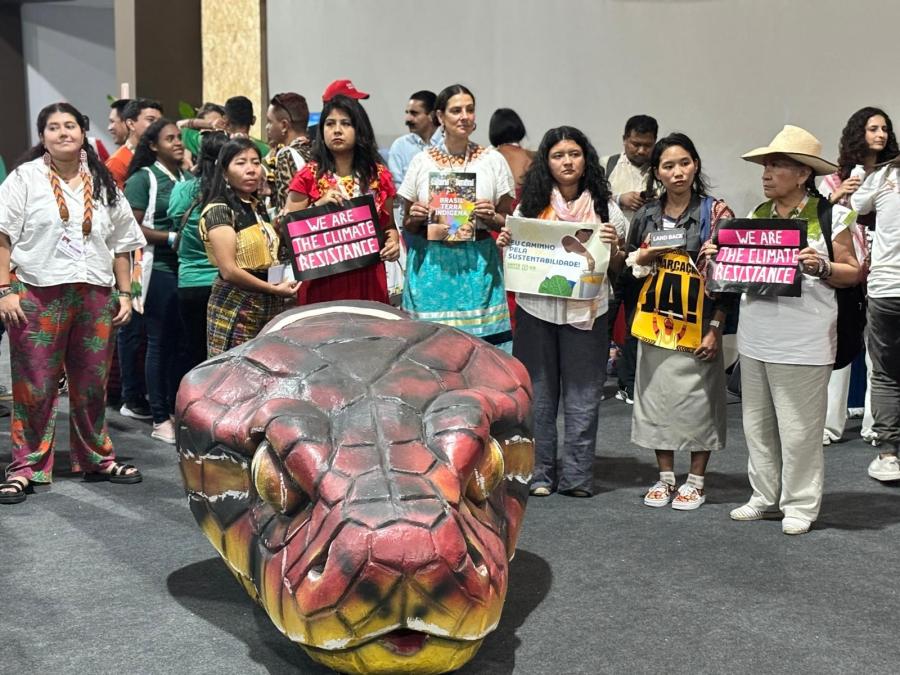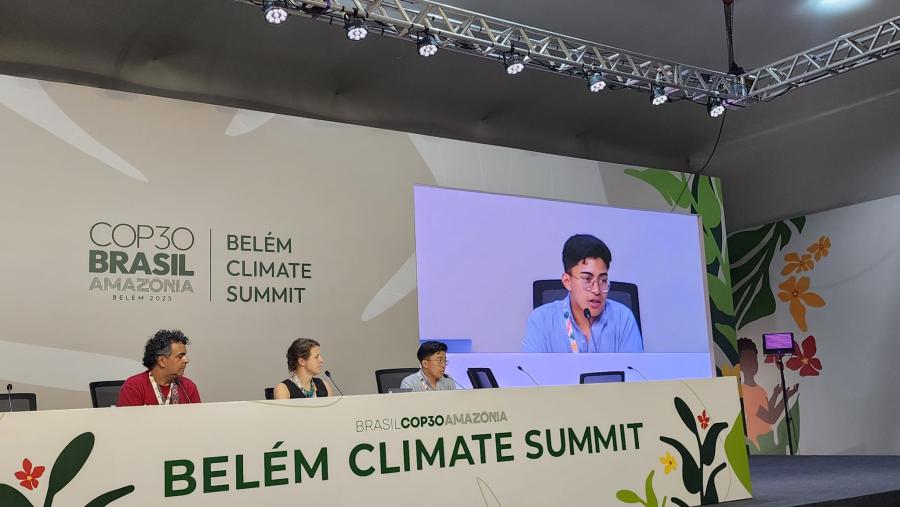
Inspired by a healer’s dream and prescient vision that destruction of the Brazilian cerrado (savannah) is endangering the red pi’ã, the bird that warns Xavante of impending danger, leader and activist Hiparidi Top’tiro sprang into action. In 2006 he founded the Mobilization of Indigenous Peoples of the Cerrado, a coalition of diverse peoples that pressures the government to implement environmental protections for the cerrado equivalent to those in place for Amazonia. In April, Top’tiro traveled to the United States to participate in the Chico Vive Conference at American University in Washington, D.C., an event co-sponsored by Cultural Survival. The conference name commemorates Chico Mendes, a Brazilian rubber tapper assassinated in 1988 for his defense of the Amazon rainforest.
Spearheaded by Linda Rabben, a faculty fellow at American University School of International Service, Chico Vive brought together Indigenous and traditional leaders from Africa, Asia, Australia, and the Americas with environmental activists, academics, students, and NGO representatives to discuss the development and challenges of global grassroots environmental activism in the 25 years since Mendes was killed. Top’tiro and other Indigenous leaders shared their experiences in grassroots environmental movements, and perhaps most importantly learned first-hand about the experiences of other Indigenous leaders and activists from other parts of the world.
In a session titled “Self-determination and conservation challenges for grassroots movements,” Top’tiro spoke about the challenges the Xavante face as Indigenous inhabitants of the central Brazilian cerrado. He described his efforts to unite Indigenous and other traditional inhabitants to press the government to pass legislation, promote policies, and devote resources to protect this unique biome. The cerrado, an extremely rich and diverse area, is home to Xavante and numerous other Indigenous groups, the source of many Amazonian rivers, and the epicenter of Brazil’s booming soy agroindustry. Xavante and other cerrado peoples now suffer the consequences of largely unregulated, multinational agribusiness and destruction of their land for export-destined soy cultivation. Environmental legislation and policy concerning the cerrado is inadequate, with significantly fewer protections than Amazonia, an ecosystem that relies on the health of the cerrado.
Top’tiro explained that since contact less than 60 years ago, the Brazilian state has consistently implemented policies that negatively affect the Xavante; current President Dilma Rouseff ’s administration continues to undermine Indigenous rights guaranteed by the 1988 Constitution. Legislators are now considering a constitutional amendment that would move decisions about the demarcation of Indigenous lands from the nonpartisan National Indian Foundation (FUNAI) to the legislative branch where they would be subject to political pressures. Such a change would have devastating results for the nation’s Indigenous peoples, many of whom have unresolved land claims.
Although Top’tiro says he “was just a boy at the time of Chico Mendes and didn’t know much about his work,” as he learned more, he said that Mendes’ efforts to unite disparate peoples served as an inspiration: protecting the cerrado implies protecting the life force and spiritual resources essential to the future and cultural continuity of Xavante and other Indigenous Peoples. “Things that protect us, like my ear ornaments, names, our dreamed music—all this comes from the cerrado. We need the cerrado because it is the source of our life force and spirituality. We need it to continue our dreaming,” he said.
On the final day of the conference, Top’tiro participated in a workshop and the film festival where he introduced “Owners of the Water: Conflict and collaboration over rivers,” a film from 2009 that features some of his activism. Top’tiro emphasized that the trip up the Rio das Mortes and visits to other Indigenous communities that are documented in the film were essential to the development of his vision to create a coalition of cerrado peoples and the founding of the coalition.
In the “New Technologies” workshop, Top’tiro had the opportunity to experiment with wireless phone technologies that several Amazonian Indigenous groups are using to document environmental destruction in their territories such as illegal timber extraction and mining. Top’tiro began to imagine ways that these technologies might be helpful to a Xavante ethno-mapping project and documentation of illegal activities in their reserves. He was also inspired by a Sierra Club presentation on activist uses of social media, and began to envision ways that new devices could help bring attention to Xavante actions, amplify their demands, and serve as a means to demand government accountability.
After attending these events Top’tiro reflected, “It is now very clear to me that the situation of Indigenous Peoples across the globe is the same. We all face the same processes of colonization, evangelization, contact with non-Indigenous peoples, [colonizing] education, relationships between Indigenous peoples and the state, and multinational corporations. Everywhere it is the same. We are the most exploited of the exploited. This is something that I really understood: there is no difference. We just speak different languages and live in different countries. But the pressure from the state and from multinational corporations is everywhere the same. Hearing my relatives tell their stories caused an understanding to deepen inside me. This was a tremendous learning experience, one that was very important for me.”
Top’tiro’s trip to the United States also provided a unique opportunity to become familiar with various US-based Indigenous and environmental groups and networks and to learn about the culture of support in this country. After three days at the conference in Washington, Top’tiro spent a week in San Francisco meeting with representatives of numerous non-profit organizations, ecclesiastical groups, and government agencies, including the US Department of State.
On behalf of the Xavante Warã Association, an organization Top’tiro founded in 1996, Top’tiro presented a proposal that is the current focus of his attention and object of his fundraising efforts. The Marãnabödödi (Forest Pathways) project proposes a system of corridors to link disparate Xavante territories along tributaries of the Rio das Mortes. These pathways would allow Xavante to hunt, collect resources, and travel without fear of reprisal on lands that were formerly theirs but are now owned by private landholders. The areas in question primarily consist of protected zones; Top’tiro and other Xavante hope to enter into friendly agreements with farmers to establish these easements. Although they are on good terms with some farmers, relations with others are extremely tense.
Because my anthropological research documenting Top’tiro’s work over the last 15 years has familiarized me with this initiative, he asked me to join him in presenting the Marãnabödödi project. I translated, filled in gaps, and provided explanations as necessary. We developed a Powerpoint that Top’tiro presented several times, including at one well attended event co-sponsored by Cultural Survival, Amazon Watch, Rainforest Action Network, and the Small Planet Fund/Institute. We are grateful to Leila Salazar, program director at Amazon Watch, for setting up this event.
Top’tiro is grateful to Cultural Survival for its help connecting him with other organizations and noninterference in the ownership of his project. He said that in contrast to previous NGO-sponsored trips, where he sensed he had been enlisted to support another organization’s agenda, on this trip he felt like a free agent. As he prepared for his voyage home to Brazil, Top’tiro said, “When I return, I am going to recount every detail of this trip. I am going to tell the young men who work with me in the Xavante Warã Association...I will tell them about our relatives’ presentations and about the activists who support us. We can’t just say no one helps us. This isn’t the way it is. There are [non-Indigenous] people who are dedicated to our cause. I noticed this and it touched me deeply.”
—Laura Graham is a Cultural Survival board member and a professor of anthropology at the University of Iowa. She wishes to thank Linda Rabben for reading and commenting on a draft of this article.



